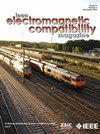Mechanisms of the Susceptibility of a Stepper Motor Control System to Narrowband IEMI Injected Through Pulse Signal Lines
IF 2.5
3区 计算机科学
Q3 ENGINEERING, ELECTRICAL & ELECTRONIC
IEEE Transactions on Electromagnetic Compatibility
Pub Date : 2025-03-31
DOI:10.1109/TEMC.2025.3535549
引用次数: 0
Abstract
Stepper motors, widely used for precise control in robotics and intelligent systems, are vulnerable to intentional electromagnetic interference (IEMI), which can disrupt their operation by affecting motor rotation. This article investigates the mechanisms and characteristics of the electromagnetic susceptibility (EMS) of a stepper motor control system to narrowband IEMI coupled through pulse signal lines. The bulk current injection method was employed, in which continuous wave (CW) and pulse modulation signals were used as the injected narrowband IEMI. The optocoupler (OC) at the drive subsystem interface was identified as the key component affecting the system's EMS, as confirmed through time- and frequency-domain experiments. The differential-mode IEMI activates the light-emitting diode in the OC, causing output logic disturbances that alter the number of driving pulses and ultimately influence the motor speed. Interestingly, at specific interference frequencies, the OC output logic level “1” is disturbed and drops to 0 V, whereas at other frequencies, the logic level “0” is disturbed and rises to 5 V. Under the CW injection, the stepper motor stops, whereas under the PM injection, the motor speed can be manipulated. The relationships between the PM signal parameters and the disturbed motor speed are modeled and experimentally validated. Finally, protection strategies were proposed and validated through experiments.步进电机控制系统对脉冲信号线注入的窄带IEMI的敏感性机制
步进电机广泛用于机器人和智能系统的精确控制,容易受到故意电磁干扰(IEMI)的影响,这种干扰可以通过影响电机的旋转来破坏其运行。本文研究了通过脉冲信号线耦合的窄带IEMI对步进电机控制系统电磁敏感性的机理和特性。采用大电流注入方法,以连续波和脉冲调制信号作为注入的窄带IEMI。通过时域和频域实验,确定了驱动子系统接口处的光耦合器(OC)是影响系统EMS的关键部件。差模IEMI激活OC中的发光二极管,导致输出逻辑干扰,改变驱动脉冲的数量,最终影响电机速度。有趣的是,在特定的干扰频率下,OC输出逻辑电平“1”受到干扰,下降到0 V,而在其他频率下,逻辑电平“0”受到干扰,上升到5 V。在连续注入下,步进电机停止,而在PM注入下,电机速度可以被操纵。建立了永磁调速信号参数与受干扰电机转速之间的关系模型,并进行了实验验证。最后,提出了相应的保护策略,并通过实验进行了验证。
本文章由计算机程序翻译,如有差异,请以英文原文为准。
求助全文
约1分钟内获得全文
求助全文
来源期刊
CiteScore
4.80
自引率
19.00%
发文量
235
审稿时长
2.3 months
期刊介绍:
IEEE Transactions on Electromagnetic Compatibility publishes original and significant contributions related to all disciplines of electromagnetic compatibility (EMC) and relevant methods to predict, assess and prevent electromagnetic interference (EMI) and increase device/product immunity. The scope of the publication includes, but is not limited to Electromagnetic Environments; Interference Control; EMC and EMI Modeling; High Power Electromagnetics; EMC Standards, Methods of EMC Measurements; Computational Electromagnetics and Signal and Power Integrity, as applied or directly related to Electromagnetic Compatibility problems; Transmission Lines; Electrostatic Discharge and Lightning Effects; EMC in Wireless and Optical Technologies; EMC in Printed Circuit Board and System Design.

 求助内容:
求助内容: 应助结果提醒方式:
应助结果提醒方式:


